The Virginia Museum of Fine Arts Leslie Cheek Theater 200 North Boulevard Richmond Virginia 23220
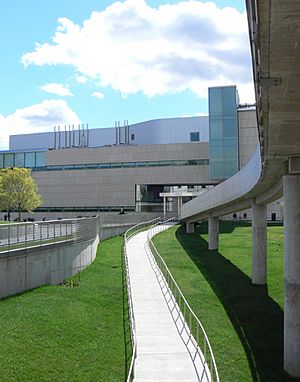 VFMA in 2010 | |
| Lua mistake in Module:Location_map at line 420: attempt to index field 'wikibase' (a nil value). | |
| Established | March 27, 1934 (1934-03-27) |
|---|---|
| Location | 200 N. Arthur Ashe Blvd., Richmond, VA 23220 |
| Blazon | Art museum |
| Accreditation | American Alliance of Museums |
| Key holdings | Faberge eggs |
| Collections | Modern and Gimmicky art |
| Collection size | 22,000 works (as of 2011) |
| Architect | Rick Mather & SMBW (2010 add-on) |
| Public transit access | Greater Richmond Transit Company bus road xvi, stop at Grove Ave. between Thompson & Robinson. |
The Virginia Museum of Fine Arts, or VMFA, is a public fine art museum in Richmond, Virginia, in the U.s.a., which opened in 1936. The museum is endemic and operated past the Commonwealth of Virginia. Private donations, endowments, and funds are used for the support of specific programs and all acquisition of artwork, also as boosted general support.
Considered among of the largest art museums in North America for foursquare footage of exhibition space, the VMFA's comprehensive fine art collection includes African fine art, American art, British sporting fine art, Fabergé, and Himalayan fine art. Ane of the first museums in the American Southward to be operated by state funds, VMFA offers gratuitous access, except for special exhibits.
The Virginia Museum of Fine Arts, together with the adjacent Virginia Historical Society, anchors the eponymous "Museum Commune" of Richmond, and area of the urban center known equally "West of the Boulevard". The museum includes the Leslie Cheek Theater, a performing arts venue.
Contents
- History
- Origins
- First expansion and major acquisitions 1940 - 1969
- Leslie Cheek Theater (Virginia Museum Theater)
- Edifice expansions 1970 - 1990
- Redesigned campus and McGlothlin fly expansion 1991 - 2010
- Permanent collection
- Gallery
- Special exhibitions
- Education and programs
History
Origins
The Virginia Museum of Fine Arts has its origins in a 1919 donation of fifty paintings to the Democracy of Virginia by Estimate John Barton Payne. During the Cracking Low, Payne collaborated with Virginia Governor John Garland Pollard to gain funding from the Federal Works Projects Administration nether President Franklin D. Roosevelt, in order to augment state funding and establish the country art museum in 1932.
The site for the museum was chosen on Richmond's Boulevard, near the corner of a contiguous half dozen-cake tract of country used as a veterans' home for Confederate soldiers, with boosted services for their wives and daughters.
The chief edifice of the VMFA was designed by Peebles and Ferguson Architects of Norfolk, and has been alternately described as Georgian Revival and English Renaissance. Commentators have said the architects expressed influence from Inigo Jones and Christopher Wren. Construction began in 1934. Two wings were originally planned, nonetheless just the key portion was congenital at the time. The museum opened on Jan 16, 1936.
Kickoff expansion and major acquisitions 1940 - 1969
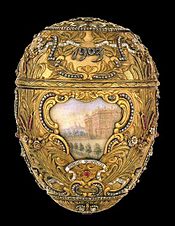
The Peter the Peachy Egg by the business firm of Fabergé, donated to the museum in 1947.
In 1947, the VMFA was given the Lillian Thomas Pratt Collection of some 150 jeweled objects by Peter Carl Fabergé and other Russian workshops, including the largest public drove of Fabergé eggs exterior of Russia. The Museum also received in 1947 the "T. Catesby Jones Collection of Mod Fine art". Further donations in the 1950s came from Adolph D. Williams and Wilkins C. Williams, and from Arthur and Margaret Glasgow. They established the museum's oldest funds used for fine art acquisitions.
Leslie Cheek, Jr. became director of the museum in 1948 and served until 1968. During these decades, he introduced many innovations and was noted as having had significant influence on the course of the institution. His obituary in the New York Times said that he "transformed [the VMFA] from a small local gallery to a nationally known cultural eye." Cheek in 1953 introduced the earth'southward first "Artmobile", a mobile tractor-trailer that carried exhibits to rural areas (prior to museum galleries existence established in afar areas). In 1960, he was the starting time in the United States to introduce night hours at an art museum.
Cheek worked with his curators and designers to cultivate a caste of theatrical "showmanship" in exhibits, such every bit velvet curtain for the Fabergé drove, a "tomb-like" setting of the museum's Egyptian exhibit, and using music to set the mood in the galleries.
During his tenure, Cheek oversaw structure of the outset addition, built in 1954 by Merrill C. Lee, Architects, of Richmond. The wing, funded in function by Paul Mellon, included a 500-seat theater. Cheek wanted to bring together the performing arts and visual arts in a unmarried cultural facility.
Leslie Cheek Theater (Virginia Museum Theater)
What is now known equally the Leslie Cheek Theater, the 500-seat proscenium theater within VMFA, was originally built in 1955 and known as the Virginia Museum Theater. It was designed under the supervision of director Cheek, a Harvard/Yale-educated builder. He consulted with Yale Drama theater engineers Donald Oenslager and George Izenour for the state-of-the-art facility. Cheek envisioned a central role for a theater arts division in the museum. The theater brought the arts of drama, acting, design, music, and dance to the art galleries.
Through the 1960s, the Virginia Museum Theater (VMT) hosted a museum-sponsored volunteer or "customs theater" company, under the direction of Robert Telford. The company presented subscription seasons of live drama to thousands annually. Local players and occasional guest professionals offered musicals (Peter Pan, e.g.), dramas (Peter Shaffer's The Royal Hunt of the Dominicus), and classics (Shakespeare's Hamlet). VMT also served equally a venue for annual programs of the Virginia Music Order, Virginia Dance Gild, and Virginia Film Club. Cheek retired from the museum in 1968 but was an adviser to the VMFA trustees nigh the adjacent director of the theater arts segmentation.
In 1969 Keith Fowler was appointed as artistic director of VMT. Under Fowler, VMT connected to serve equally the headquarters for the Dance, Pic and Music societies. He is known for having expanded and upgrading the alive theater operations, establishing Richmond's first resident Actors Equity/LORT company. Both customs actors and New-York based professionals became function of this. a troupe that included core members Marie Goodman Hunter, Janet Bell, Lynda Myles, East.Yard. Marshall, Ken Letner, James Kirkland, Rachael Lindhart, and dramaturg M. Elizabeth Osborn.
Fowler retained a focus on classics and musicals, just added an emphasis on new plays and U.Due south. premieres of foreign works. His debut production in 1969, Marat/Sade, was produced with the first racially integrated company on the VMT phase. This decision generated controversy.
The company became known as VMT Rep (for "repertory"). Fowler attracted national find in 1973 with his production of Macbeth, starring E.G. Marshall. Critic Clive Barnes of The New York Times hailed it as the "'Fowler Macbeth'... "splendidly vigorous... probably the goriest Shakespearean product I accept seen since Peter Brook's 'Titus Andronicus'." As Fowler heightened the professional person quality of the theater, VMT led Richmond into what some call back as a gold age of theater.
The company commissioned and produced eight American and World premieres, introducing new plays by Romulus Linney and A.R. Gurney, as well as by major foreign authors, such every bit Harold Pinter, Joe Orton, Athol Fugard, and Peter Handke. In 1975 the Soviet Arts Delegate provided coverage on Moscow Television receiver for Fowler'due south U.Southward premiere of Maxim Gorky'south Our Father (originally Poslednje in Russian). This VMT product transferred to New York City, where information technology premiered at the Manhattan Theater Club.
Over viii years, VMT'south subscription audition increased from iv,300 to 10,000 patrons. Fowler resigned in 1977 after a dispute with VMFA administration over the content in VMT's premiere of Romulus Linney's Childe Byron.
Successive artistic directors Tom Markus and Terry Burglar renamed the company and its playhouse "TheatreVirginia." As with all American professional person non-for-profit performing arts organizations, TheatreVirginia ran mounting deficits for years, underwritten by trustees.
Only in 2002, the decision was fabricated to close TheatreVirginia. It struggled financially to operate in a country-supported museum. In addition, that twelvemonth audiences declined, fearing a serial of regional sniper attacks that killed five.
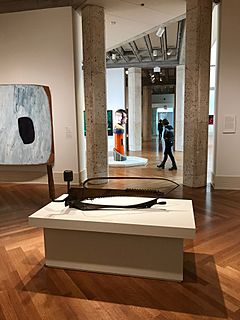
VMFA Lewis Galleries in 2021
For eight years the theater was dormant. It was renovated and revived as a alive performance space in 2011, and named the Leslie Cheek Theater in honor of its early director. The theater's reopening has returned alive performing arts to the centre of the Virginia Museum. The Leslie Cheek Theater does not support a resident company, but is available for bookings of special theater, music, film, and dance showings.
Building expansions 1970 - 1990
The second addition, the S Wing, was designed by Baskervill & Son Architects of Richmond and completed in 1970. It featured four new permanent galleries and a large gallery for loan exhibitions, equally well as a new library, photography lab, art storage rooms, and staff offices. A gift of funds from Sydney and Frances Lewis of Richmond in 1971, provided for the acquisition of Art Nouveau objects and piece of furniture.
A tertiary addition, known as the Northward Wing, was designed past Hardwicke Associates, Inc. of Richmond and completed in 1976. It included an adjacent sculpture garden with a cascading fountain, designed past mural architect Lawrence Halprin. The North Wing was designed as the new master archway for the museum, with a separate dedicated entrance added for the theater. It provided three more gallery areas – 2 for temporary exhibitions and i for the Lewis Family's Art Nouveau Collection while also housing a gift shop, members' dining room, and other visitor functions. Even so, the curved walls of the North Wing's "kidney-shaped" blueprint proved to be functionally awkward and impractical, and it was later replaced. The 1976 fly and sculpture garden were afterward demolished to make room for the 2010 McGlothlin Wing.
In the following years, the Lewis and Mellon families proposed major donations from their extensive private collections, and helped provide the funds to firm them. In December 1985, the museum opened its fourth addition, the ninety,000 foursquare feet (8,400 m2) square human foot West Fly. The architects, Hardy Holzman Pfeiffer Assembly of New York, were chosen past the Lewises based on their appreciation of the firm's 1981 pattern for the Best Products headquarters edifice due north of Richmond. The wing at present houses the collections of these two families.
Redesigned campus and McGlothlin wing expansion 1991 - 2010
| Dwelling For Confederate Women | |
| U.S. National Register of Historic Places | |
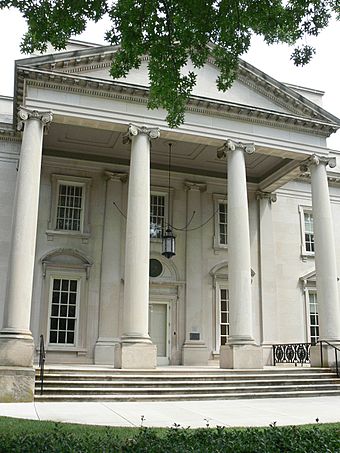 | |
| Location | 301 Due north. Sheppard St., Richmond, Virginia |
|---|---|
| Expanse | ii acres (0.81 ha) |
| Built | 1932 |
| Architect | Lee, Merrill |
| Architectural style | Federal, Federal Revival |
| NRHP referenceNo. | 85002767 |
| Significant dates | |
| Added to NRHP | November 7, 1985 |
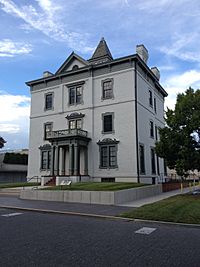
In 1993, the Commonwealth of Virginia transferred the care of the Robinson Business firm from the Department of General Services to VMFA. The nearly fourteen acre property of Robinson House, a former veterans camp, was transferred between state agencies to the museum. Offset in 2001, the VMFA created a master plan for development of this land in what was otherwise a built-out residential function of the city.
By the 1990s, the functions of the adjacent Amalgamated Domicile for Women had ceased, and its last residents moved out. In 1999, the former abode was adapted for use as the Center for Didactics and Outreach (at present the Pauley Center), housing the museum's Office of Statewide Partnerships.
The VMFA undertook a $150-million building expansion to increase the museum'southward gallery infinite past fifty pct, calculation 165,000 square feet (15,300 yard2). The new fly opened in 2010 and was named in honor of patrons James W. and Frances G. McGlothlin. The museum reoriented the McGlothlin Wing by reinstating the entrance on the Boulevard, the same as with the original 1936 entrance.
The pattern includes a iii-story atrium named for Louise B. and J. Harwood Cochrane, with a twoscore-foot (12 m)-tall glass wall to the eastward and wide expanses of glass walls to the west, and a partially glazed roof. The London-based architect Rick Mather collaborated with Richmond-based SMBW Architects in the design of the building, while landscape architecture was handled by OLIN. Landscaping included a new four-acre (sixteen,000 one thousandtwo) sculpture garden, named for philanthropists E. Claiborne and Lora Robins.
American art is the major focus of exhibitions in the McGlothlin Wing. In 2008 the museum received a $200,000 grant from the Luce Foundation to back up the installation and interpretation of its American collections. Mather's design for the VMFA expansion earned a 2011 RIBA International Honor for architectural excellence.
Permanent collection
The Virginia Museum of Fine Arts has divided its encyclopedic collections into several broad curatorial departments, which largely correspond to the galleries:
- African Art: In 1994 and 1995, the museum exhibited its entire 250-object African fine art collection in Spirit of the Motherland: African Fine art at the Virginia Museum of Fine Arts. As of 2011, the collection has grown to around 500 objects, with detail strengths in the fine art of the Kuba, the Akan, the Yoruba, and the Kongo peoples, and the art of Republic of mali.
- American Fine art: The American art collection began with twenty works of the John Barton Payne donation. Since the 1980s, the museum has begun to systematically build its holdings in American art, aided in 1988 past the cosmos of an endowment by patrons Harwood and Louise Cochrane to support such acquisitions.
- In 2005, the McGlothlin family unit promised a bequest of their collection of American art and financial support, valued at well above $100 million.
- Aboriginal American art
- Ancient art: Begun in 1936, the Aboriginal collection expanded under Manager Leslie Cheek, with the advice of the Brooklyn Museum and other institutions. The collection consists of works from the Ancient Egyptian, Aboriginal Greek, Phrygian, Etruscan, Ancient Roman, and Byzantine civilizations. It includes one of ii ancient Egyptian mummies in the city of Richmond, "Tjeby" (the other is at the University of Richmond).
- Art Nouveau & Art Deco: Begun from the core drove of furniture and decorative arts the Lewis family unit began assembling in 1971; today it includes Art Nouveau works past Hector Guimard, Emile Galle, Louis Majorelle, Louis Condolement Tiffany, works by the Vienna Secession and Peter Behrens, Arts & Crafts works by Charles Rennie Mackintosh, Frank Lloyd Wright, Stickley, and Greene & Greene, and Parisian Fine art Deco pieces by Eileen Grayness and Émile-Jacques Ruhlmann.
- Eastward Asian art: Begun in 1941, the Due east Asian collection consists of Chinese, Japanese and Korean art. The drove includes Chinese jade, bronzes and Buddhist sculpture; Japanese sculpture, and paintings from Kyoto; as well as Korean ceramics and bronzes from two private collections. In 2004, the drove added two imperial Buddhist paintings from the Qing dynasty, dating from 1740. The collection includes the Rene and Carolyn Balcer Collection of works by the Japanese woodblock artist Kawase Hasui. That collection consists of some 800 works, woodblock prints, screens, watercolors and other works by Hasui, including rarely seen prints fabricated past Hasui prior to the 1923 earthquake that destroyed half of Tokyo.
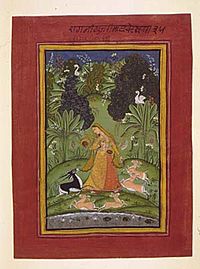
Miniature watercolor painting from Rajasthan, in the S Asian drove
- European fine art: The European drove began with the original 1919 Payne donation, and now includes works by Bacchiacca, Murillo, Poussin, Rosa, Gentileschi, Goya, and Bouguereau.
- In 1970, Ailsa Mellon Bruce donated some 450 European decorative objects, including a group of 18th- and 19th-century gilded, porcelain and enamel boxes.
- Pinkney Fifty. Near (1927 - 1990) was curator of the Virginia Museum of Fine Arts for thirty years. He was responsible for the museum's conquering of many works of European art, including arranging for the museum to buy the Francisco Goya portrait of Full general Nicolas Guye (long believed to be the near valuable work of art in the museum's collections) from John Lee Pratt. The Guye portrait by Goya is now on view in the posthumously created Pinkney Near Gallery at the VMFA. In 1989 Pinkney Near was named to the newly created post of Paul Mellon Curator and senior research curator, a post in which he continued to work closely with the Mellon Collection and Paul Mellon. Malcolm Cormack succeeded Pinkney Near as Paul Mellon Curator of European Art, from 1991 until his retirement in 2003. Mitchell Merling became Cormack's successor as curator of the Mellon Drove.
- Paul Mellon's donations added to the French Impressionist and Post-Impressionist works and a collection of British Sporting Art, given to the museum in 1983. At his death in 1999, Mellon bequeathed additional French and British works, including five paintings by George Stubbs. The Mellon Galleries closed Jan 2, 2018 for renovations, with a scheduled reopening in 2020. Curator Mitchell Merling selected 70 major works from the VMFA Mellon Collection to tour during this period on loan to museums, such every bit the Frick Art and Historical Center in Pittsburgh, the Frist Center for the Visual Arts in Nashville, and the Musee de la Chasse et de la Nature in Paris. Works sent on loan during renovations of the galleries included paintings by Vincent van Gogh, Henri Rousseau, and George Stubbs.
- English argent: In 1997 a collection of 18th and 19th-century English language silver was given to the museum by Jerome and Rita Gans.
- Fabergé The Pratt Fabergé drove, the largest drove of Fabergé eggs exterior Russia, includes 5 Majestic Easter Eggs: the Rock Crystal Egg of 1896, the Pelican Egg of 1898, the Peter the Great Egg of 1903, the Tsarevich Egg of 1912, and the Cherry Cross with Majestic Portraits Egg of 1915.
- The S Asian drove comprises works from what are today India, Pakistan, Bangladesh, Sri Lanka, Nepal and Tibet. The collection began in the late 1960s, with the initial cadre of the Himalayan collection existence acquired in 1968.
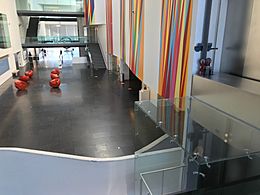
VFMA Cochrane Atrium in 2021
When the 2010 wing was completed, a 27-ton marble belatedly-Mughal garden pavilion from Rajasthan was installed inside the galleries.
- Modern & Contemporary: The core of the Modern & Gimmicky collection was assembled by Sydney and Frances Lewis in the mid- to late-20th century. Much of the more than 1,200 works in their collection were acquired past trading products (such as appliances and electronics) from their company, Best Products, to artists in exchange for works, while at the aforementioned fourth dimension befriending many of them.
In 2019, the Virginia Museum of Fine art commissioned a big-scale monumental sculpture from artist Kehinde Wiley that was installed in front end of the museum. The work in statuary, which Wiley had titled Rumors of War, was modeled subsequently one of Monument Avenue's Confederate statues after visited Richmond for a retrospective exhibition of his artwork held at the museum in 2016.
Gallery
-

Junius Brutus Stearns, Washington as Farmer at Mount Vernon, 1851
-

Henri Rousseau, Tropical Landscape: American Indian Struggling with a Gorilla, 1910
Special exhibitions
In addition to the galleries that display selections of the permanent collection, the Virginia Museum of Fine Arts presents special exhibitions of artwork drawn from its own and others' collections, too as work of active artists.
In 1941, the museum presented an exhibition of Modernist works past artists of the Schoolhouse of Paris from the collection of Walter P. Chrysler Jr. (which later became the basis for the Chrysler Museum of Art).
In the 1950s, VMFA originated shows such every bit "Article of furniture of the One-time South" (1952), "Blueprint of Scandinavia" (1954) and "Masterpieces of Chinese Art" (1955). In the 1960s, there were "Masterpieces of American Silvery", followed past "Painting in England, 1700–1850," which drew from the private collections of Mr. and Mrs. Paul Mellon. At the fourth dimension, it was the nigh comprehensive exhibition of British painting always presented in the United States. In 1967, the museum also mounted a major exhibition of the work of the English language social satirist William Hogarth.
In 1978, the museum presented an exhibition on Colonial cabinetmaking in early Virginia, "Piece of furniture of Williamsburg and Eastern Virginia, 1710–1790." Another first, and one that received widespread international attending, was the 1983 exhibition "Painting in the South: 1564–1980."
In the fall of 1996, VMFA was one of five major American museums to present "Fabergé in America" and "The Lillian Thomas Pratt Collection of Fabergé." These two exhibitions, featuring more 400 objects and 15 majestic Easter eggs, drew more than 130,000 visitors to Richmond.
In 1997, the VMFA showed "William Blake: Illustrations of the Volume of Task," an exhibition that featured a complete ready of 21 engravings past English language Romantic artist William Blake, created in 1825 and purchased past the museum in 1973. In addition to the engravings, the exhibit included six of the 1805 watercolors upon which Blake based them, on view and on loan from New York's Pierpont Morgan Library. Likewise on view were a complete fix of the creative person's preliminary drawings from the Fitzwilliam Museum at Cambridge University and the "New Zealand" ready of copies of Blake'southward engravings from the Yale Center for British Art.
In 1999, the museum presented "Splendors of Aboriginal Egypt," an exhibition assembled from the renowned drove of the Pelizaeus Museum in Hildesheim, Federal republic of germany. Most a quarter of a million people saw the show in Richmond. It was one of the largest exhibitions of Egyptian art ever to bout the United states.
In 2011, VMFA was ane of seven museums worldwide chosen to exhibit one hundred seventy-six paintings from the personal drove of Pablo Picasso. The exhibit was held from Feb xix – May 15, 2011 in ten galleries of the newly renovated museum. Director Alex Nyerges noted: "An exhibition this monumental is extremely rare, especially one that spans the entire career of a figure who many consider the almost influential, innovative and creative artist of the 20th century." The drove of paintings was from a permanent collection housed in the Musée Picasso, then under renovation.
The VMFA is a member of the French Regional & American Museums Exchange (FRAME).
Education and programs
The Role of Statewide Partnerships delivered programs and exhibitions throughout the republic via a voluntary network of more than than 350 nonprofit institutions (museums, galleries, fine art organizations, schools, community colleges, colleges and universities). Through this program, the museum offered crated exhibitions, arts-related audiovisual programs, symposia, lectures, conferences and workshops by visual and performing artists. The traveling artmobile program, tailored to aid students meet the land'south Standards of Learning, was also included.
VMFA has offered in-house educational programs that are supported past multiple specialized studios and on-site exhibition space. These take included courses in cartoon, painting, sculpture, photography, fashion, digital arts, and mixed media.
Grouping highlights tours are offered daily. Chiliad-12 group tours are also offered, incorporating the Virginia Standards of Learning. All college student tours of VMFA'southward permanent collection — guided and self-directed — are free. Tours can be requested online.
VMFA's ARTshare is a multiyear digital initiative to expand the museum's digital outreach and make its collection more attainable.
VMFA established a Fellowship Programme in 1940 which, by 2011, had delivered grants in excess of $5 one thousand thousand with i,250 awards to Virginia artists since the program's inception. The fellowship funds come from a privately endowed fund administered by VMFA. The Fellowship Program was initially funded by the belatedly John Lee Pratt of Fredericksburg (the husband of Lillian Pratt, donor of the museum's Fabergé collection). By 2011, fellowships were primarily funded through the Pratt endowment and supplemented by gifts from the Lettie Pate Whitehead Foundation and the J. Warwick McClintic Jr. Scholarship Fund. Notable recipients of VMFA fellowship grants include Vince Gilligan, Emmet Gowin, David Freed, Laura Pharis, Richard Carlyon, and Nell Blaine.
Coordinates: 37°33′25″Due north 77°28′26″Westward / 37.55698°Due north 77.47396°Westward / 37.55698; -77.47396
Source: https://kids.kiddle.co/Virginia_Museum_of_Fine_Arts
0 Response to "The Virginia Museum of Fine Arts Leslie Cheek Theater 200 North Boulevard Richmond Virginia 23220"
Post a Comment